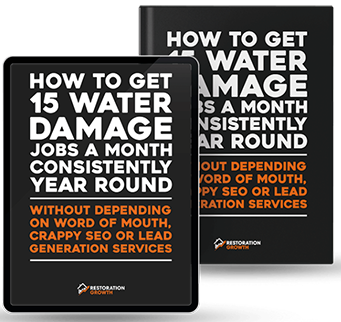
Understanding CPC
CPC stands for Cost Per Click, and it’s super important in your PPC (Pay-Per-Click) campaigns. It’s like the price tag for each visitor who clicks on your ad. The lower your CPC, the more bang for your buck you get in your PPC campaigns. This is crucial for your restoration company because you want to attract as many customers as possible without overspending.
To really understand CPC, think about it as buying a spot in a race. Each spot (or click) has a cost, and you want the best spot for the least money. A lower CPC means you can have more ads or clicks for the same amount of money. It’s all about getting more people to see your ad and visit your website while keeping your costs down.
Different factors can affect your CPC, like the competitiveness of your keywords or the quality of your ads. If lots of other restoration companies are bidding on the same keywords, the cost might go up. It’s a bit like bidding in an auction; the more people want the same thing, the higher the price can go.
How to Figure Out Your Current CPC
Knowing your current CPC is like checking the speedometer in your car; it tells you how fast (or in this case, how costly) your PPC journey is. To find your CPC, start by logging into your PPC account, like Google Ads. Look for the ‘Campaigns’ tab where you can see all your active ads.
In your campaign dashboard, you’ll see a bunch of numbers. Look for the column that says ‘Cost’ and another that says ‘Clicks’. Your CPC is basically the cost divided by the number of clicks. It’s like figuring out how much each piece of a pie costs by dividing the total cost by the number of pieces.
If math isn’t your thing, don’t worry. Most PPC platforms do the math for you and show your average CPC for each campaign. You can also use these tools to track changes in your CPC over time, helping you understand how your changes affect your costs. Keeping an eye on your CPC helps you drive your PPC campaigns more efficiently, just like watching your speed helps you drive more safely.
The Link Between Quality Score & CPC
Quality Score is super important in PPC campaigns. It’s like a report card for your ads. A high Quality Score means Google thinks your ad is relevant and useful to people searching for your kind of services. This score affects your Cost Per Click (CPC). The better your score, the lower your CPC can be.
Think of Quality Score as a teacher grading your homework. If your ads and landing pages are top-notch (like having A+ homework), Google gives you a high score. A high score can mean lower costs for ad spots. It’s like getting a discount because your ads are so good. Google rewards you for creating ads that people find helpful.
To improve your Quality Score, focus on making your ads super relevant to what people are searching for. Also, make sure your landing pages are awesome. They should load fast, look good, and have exactly what people need. High-quality ads and landing pages can lead to a higher Quality Score, which can help lower your CPC.
Leveraging Geo-Targeting for Lower CPC
Geo-Targeting is a cool tool in PPC campaigns. It lets you show your ads to people in specific locations. This is perfect for a restoration company, as you probably serve certain areas or cities. By targeting these areas, you can lower your Cost Per Click (CPC). It’s like putting your ads in front of neighbors instead of the whole world.
When you use Geo-Targeting, you’re focusing your ad money on areas where your potential customers live. This can mean less competition for ad spots, which often leads to a lower CPC. It’s like advertising in a local newspaper instead of a national one – it’s more cost-effective because you’re reaching the right people.
Setting up Geo-Targeting is pretty easy. In your PPC campaign settings, you can choose specific cities, zip codes, or even a radius around a location. This helps make sure your ads are seen by people who can actually use your restoration services. It’s a smart way to spend your ad budget and can help you get more clicks for your money.
Optimizing Ad Scheduling to Cut Costs
Ad scheduling is a smart way to manage your PPC campaigns for your restoration company. It lets you choose when your ads show up. Think of it like picking the best time to open your store. You want to be open when your customers are around, right? With ad scheduling, you can have your ads appear on days and times when potential customers are most likely to search for your services.
For example, if you notice more people are looking for restoration services during certain hours or on specific days, adjust your ad schedule to match these times. This way, you’re not spending money on ads in the middle of the night when fewer people are searching. It’s like turning off the lights in your store when it’s closed to save on electricity.
By tweaking your ad schedule, you can cut down on wasted ad spend and focus your budget on the times you’re most likely to get clicks. This can help lower your overall Cost Per Click (CPC) because you’re targeting more effectively. Regularly analyzing when you get the most traffic and adjusting your schedule accordingly can make a big difference in your PPC campaign costs.
Regularly Reviewing and Refining Your PPC Strategy
Keeping your PPC campaigns effective means regularly checking in and making updates. Think of it like tuning a car. To keep it running smoothly, you need to check under the hood, change the oil, and make adjustments. The same goes for your PPC campaigns. Regular reviews can help you spot opportunities to lower your CPC and make your ads more effective.
During these reviews, look at things like which keywords are performing best, how your ads are doing compared to others, and whether you’re reaching the right audience. Maybe some keywords are costing too much but not bringing enough business. Or perhaps you could try different ad texts to see what works better.
Finally, don’t be afraid to test new strategies. The world of online advertising changes fast, and what worked last year might not work as well now. Regularly refining your approach, like trying new keywords or adjusting your targeting, can help you stay ahead of the game. Keep learning and adjusting, and your PPC campaigns can continue to drive valuable business for your restoration company.







